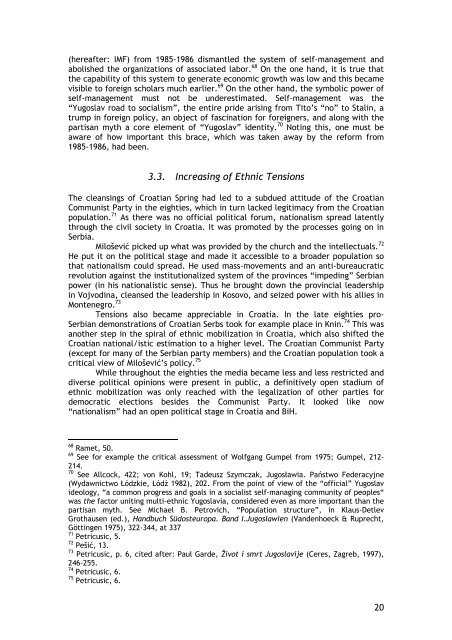Synthetic report - EURAC
Synthetic report - EURAC
Synthetic report - EURAC
Create successful ePaper yourself
Turn your PDF publications into a flip-book with our unique Google optimized e-Paper software.
(hereafter: IMF) from 1985-1986 dismantled the system of self-management and<br />
abolished the organizations of associated labor. 68 On the one hand, it is true that<br />
the capability of this system to generate economic growth was low and this became<br />
visible to foreign scholars much earlier. 69 On the other hand, the symbolic power of<br />
self-management must not be underestimated. Self-management was the<br />
“Yugoslav road to socialism”, the entire pride arising from Tito’s “no” to Stalin, a<br />
trump in foreign policy, an object of fascination for foreigners, and along with the<br />
partisan myth a core element of “Yugoslav” identity. 70 Noting this, one must be<br />
aware of how important this brace, which was taken away by the reform from<br />
1985-1986, had been.<br />
3.3. Increasing of Ethnic Tensions<br />
The cleansings of Croatian Spring had led to a subdued attitude of the Croatian<br />
Communist Party in the eighties, which in turn lacked legitimacy from the Croatian<br />
population. 71 As there was no official political forum, nationalism spread latently<br />
through the civil society in Croatia. It was promoted by the processes going on in<br />
Serbia.<br />
Milošević picked up what was provided by the church and the intellectuals. 72<br />
He put it on the political stage and made it accessible to a broader population so<br />
that nationalism could spread. He used mass-movements and an anti-bureaucratic<br />
revolution against the institutionalized system of the provinces “impeding” Serbian<br />
power (in his nationalistic sense). Thus he brought down the provincial leadership<br />
in Vojvodina, cleansed the leadership in Kosovo, and seized power with his allies in<br />
Montenegro. 73<br />
Tensions also became appreciable in Croatia. In the late eighties pro-<br />
Serbian demonstrations of Croatian Serbs took for example place in Knin. 74 This was<br />
another step in the spiral of ethnic mobilization in Croatia, which also shifted the<br />
Croatian national/istic estimation to a higher level. The Croatian Communist Party<br />
(except for many of the Serbian party members) and the Croatian population took a<br />
critical view of Milošević’s policy. 75<br />
While throughout the eighties the media became less and less restricted and<br />
diverse political opinions were present in public, a definitively open stadium of<br />
ethnic mobilization was only reached with the legalization of other parties for<br />
democratic elections besides the Communist Party. It looked like now<br />
“nationalism” had an open political stage in Croatia and BiH.<br />
68 Ramet, 50.<br />
69 See for example the critical assessment of Wolfgang Gumpel from 1975; Gumpel, 212-<br />
214.<br />
70 See Allcock, 422; von Kohl, 19; Tadeusz Szymczak, Jugosławia. Państwo Federacyjne<br />
(Wydawnictwo Łódzkie, Łódź 1982), 202. From the point of view of the “official” Yugoslav<br />
ideology, “a common progress and goals in a socialist self-managing community of peoples“<br />
was the factor uniting multi-ethnic Yugoslavia, considered even as more important than the<br />
partisan myth. See Michael B. Petrovich, “Population structure”, in Klaus-Detlev<br />
Grothausen (ed.), Handbuch Südosteuropa. Band I.Jugoslawien (Vandenhoeck & Ruprecht,<br />
Göttingen 1975), 322-344, at 337<br />
71 Petricusic, 5.<br />
72 Pešić, 13.<br />
73 Petricusic, p. 6, cited after: Paul Garde, Život i smrt Jugoslavije (Ceres, Zagreb, 1997),<br />
246-255.<br />
74 Petricusic, 6.<br />
75 Petricusic, 6.<br />
20

















